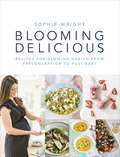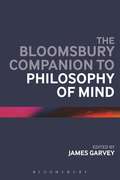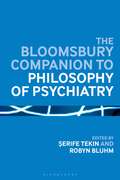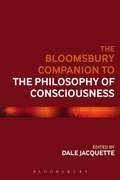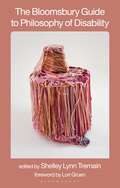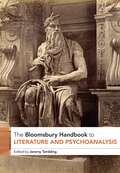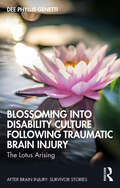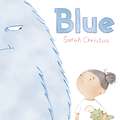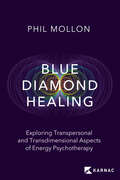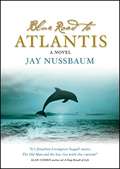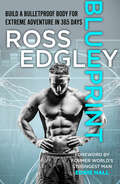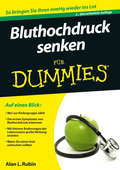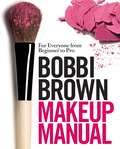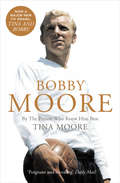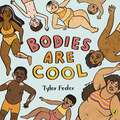- Table View
- List View
Blooming Delicious: Your Pregnancy Cookbook – from Conception to Birth and Beyond
by Sophie WrightWhen Sophie Wright, an outstanding chef with a passion for healthy and delicious food, found out she was pregnant, she decided to make it her mission to create easy, nutrient-packed and great-tasting recipes to enjoy during pregnancy. In this brilliant pregnancy cookbook, Sophie shares her favourite recipes for every stage, from pre-conception right through to early motherhood. With the help of top nutritional therapist Henrietta Norton, Sophie carefully selects and combines ingredients to nourish you and your baby at each crucial stage. Beautifully photographed and designed, this stunning book includes over 100 mouth-watering recipes that deliver on taste and nutrition. Divided into trimesters, pre- and post-pregnancy, recipes include: Miso Salmon with Edamame, Super Seedy Soda Bread, Chicken Burgers with Avocado, Banana, Date and Coconut Energy Truffles, and more!
The Bloomsbury Companion to Philosophy of Mind (Bloomsbury Companions)
by James GarveyFeaturing thirteen specially commissioned chapters on core subjects, The Bloomsbury Companion to Philosophy of Mind is an essential tool for all those studying and working in the field, purpose-built for use on courses in this area of philosophy.Beginning with 'How to Use this Book' the Companion includes overviews of perennial problems and new directions in contemporary philosophy of mind, an extended glossary of terms for quick reference, a detailed chronology, a guide to research for ongoing study and a comprehensive bibliography of key classic and contemporary publications in the philosophy of mind. From new questions concerning qualia, representation, embodiment and cognition to fresh thinking about the long-standing problems of physicalism, dualism, personal identity and mental causation, this book is an authoritative survey of the latest research from experts in one of the most active areas of philosophical inquiry.
The Bloomsbury Companion to Philosophy of Mind (Bloomsbury Companions)
by James GarveyFeaturing thirteen specially commissioned chapters on core subjects, The Bloomsbury Companion to Philosophy of Mind is an essential tool for all those studying and working in the field, purpose-built for use on courses in this area of philosophy.Beginning with 'How to Use this Book' the Companion includes overviews of perennial problems and new directions in contemporary philosophy of mind, an extended glossary of terms for quick reference, a detailed chronology, a guide to research for ongoing study and a comprehensive bibliography of key classic and contemporary publications in the philosophy of mind. From new questions concerning qualia, representation, embodiment and cognition to fresh thinking about the long-standing problems of physicalism, dualism, personal identity and mental causation, this book is an authoritative survey of the latest research from experts in one of the most active areas of philosophical inquiry.
The Bloomsbury Companion to Philosophy of Psychiatry (Bloomsbury Companions)
by Serife Tekin Robyn BluhmThis book explores the central questions and themes lying at the heart of a vibrant area of philosophical inquiry. Aligning core issues in psychiatry with traditional philosophical areas, it presents a focused overview of the historical and contemporary problems dominating the philosophy of psychiatry. Beginning with an introduction to philosophy of psychiatry, the book addresses what psychiatry is and distinguishes it from other areas of medical practice, other health care professions and psychology. With each section of the companion corresponding to a philosophical subject, contributors systematically cover relevant topics in philosophy of mind, philosophy of science, ethics, social and political philosophy, metaphysics, epistemology, phenomenology, and philosophy of medicine. Looking ahead to new research directions, chapters address recent issues including the metaphysics of mental disorders, gender and race in psychiatry and psychiatric ethics. Featuring discussion questions, suggestions for further reading and an annotated bibliography, The Bloomsbury Companion to Philosophy of Psychiatry is an accessible survey of the debates and developments in the field suitable for undergraduates in philosophy and professional philosophers new to philosophy of psychiatry.
The Bloomsbury Companion to Philosophy of Psychiatry (Bloomsbury Companions)
by Serife Tekin Robyn BluhmThis book explores the central questions and themes lying at the heart of a vibrant area of philosophical inquiry. Aligning core issues in psychiatry with traditional philosophical areas, it presents a focused overview of the historical and contemporary problems dominating the philosophy of psychiatry. Beginning with an introduction to philosophy of psychiatry, the book addresses what psychiatry is and distinguishes it from other areas of medical practice, other health care professions and psychology. With each section of the companion corresponding to a philosophical subject, contributors systematically cover relevant topics in philosophy of mind, philosophy of science, ethics, social and political philosophy, metaphysics, epistemology, phenomenology, and philosophy of medicine. Looking ahead to new research directions, chapters address recent issues including the metaphysics of mental disorders, gender and race in psychiatry and psychiatric ethics. Featuring discussion questions, suggestions for further reading and an annotated bibliography, The Bloomsbury Companion to Philosophy of Psychiatry is an accessible survey of the debates and developments in the field suitable for undergraduates in philosophy and professional philosophers new to philosophy of psychiatry.
The Bloomsbury Companion to the Philosophy of Consciousness (Bloomsbury Companions)
by Katherine J. Morris Daniel Stoljar Ted Honderich Paul Bello Scott Soames Dale JacquetteFrom Descartes and Cartesian mind-body dualism in the 17th century though to 21st-century concerns about artificial intelligence programming, The Bloomsbury Companion to the Philosophy of Consciousness presents a compelling history and up-to-date overview of this burgeoning subject area.Acknowledging that many of the original concepts of consciousness studies are found in writings of past thinkers, it begins with introductory overviews to the thought of Descartes through to Kant, covering Brentano's restoration of empiricism to philosophical psychology and the major figures of the late 19th and early 20th centuries: Russell, Wittgenstein, Ryle and James. These opening chapters on the forces in the history of consciousness lay the groundwork needed to understand how influential contemporary thinkers in the philosophy of mind interpret the concept of consciousness. Featuring leading figures in the field, Part II discusses current issues in a range of topics progressing from the so-called hard problem of understanding the nature of consciousness, to the methodology of invoking the possibility of philosophical zombies and the prospects of reductivism in philosophy of mind. Part III is dedicated to new research directions in the philosophy of consciousness, including chapters on experiment objections to functionalism and the scope and limits of artificial intelligence. Equipped with practical research resources including an annotated bibliography, a research guide and a glossary, The Bloomsbury Companion to the Philosophy of Consciousness is an authoritative guide for studying the past, present and future of consciousness.
The Bloomsbury Companion to the Philosophy of Consciousness (Bloomsbury Companions)
by Katherine J. Morris Daniel Stoljar Ted Honderich Paul Bello Scott Soames Dale JacquetteFrom Descartes and Cartesian mind-body dualism in the 17th century though to 21st-century concerns about artificial intelligence programming, The Bloomsbury Companion to the Philosophy of Consciousness presents a compelling history and up-to-date overview of this burgeoning subject area.Acknowledging that many of the original concepts of consciousness studies are found in writings of past thinkers, it begins with introductory overviews to the thought of Descartes through to Kant, covering Brentano's restoration of empiricism to philosophical psychology and the major figures of the late 19th and early 20th centuries: Russell, Wittgenstein, Ryle and James. These opening chapters on the forces in the history of consciousness lay the groundwork needed to understand how influential contemporary thinkers in the philosophy of mind interpret the concept of consciousness. Featuring leading figures in the field, Part II discusses current issues in a range of topics progressing from the so-called hard problem of understanding the nature of consciousness, to the methodology of invoking the possibility of philosophical zombies and the prospects of reductivism in philosophy of mind. Part III is dedicated to new research directions in the philosophy of consciousness, including chapters on experiment objections to functionalism and the scope and limits of artificial intelligence. Equipped with practical research resources including an annotated bibliography, a research guide and a glossary, The Bloomsbury Companion to the Philosophy of Consciousness is an authoritative guide for studying the past, present and future of consciousness.
The Bloomsbury Guide to Philosophy of Disability
by Shelley Lynn TremainThe Bloomsbury Guide to Philosophy of Disability is a revolutionary collection encompassing the most innovative and insurgent work in philosophy of disability. Edited and anthologized by disabled philosopher Shelley Lynn Tremain, this book challenges how disability has historically been represented and understood in philosophy: it critically undermines the detrimental assumptions that various subfields of philosophy produce; resists the institutionalized ableism of academia to which these assumptions contribute; and boldly articulates new anti-ableist, anti-sexist, anti-racist, queer, anti-capitalist, anti-carceral, and decolonial insights and perspectives that counter these assumptions. This rebellious and groundbreaking book's chapters–most of which have been written by disabled philosophers–are wide-ranging in scope and invite a broad readership. The chapters underscore the eugenic impetus at the heart of bioethics; talk back to the whiteness of work on philosophy and disability with which philosophy of disability is often conflated; and elaborate phenomenological, poststructuralist, and materialist approaches to a variety of phenomena. Topics addressed in the book include: ableism and speciesism; disability, race, and algorithms; race, disability, and reproductive technologies; disability and music; disabled and trans identities and emotions; the apparatus of addiction; and disability, race, and risk. With cutting-edge analyses and engaging prose, the authors of this guide contest the assumptions of Western disability studies through the lens of African philosophy of disability and the developing framework of crip Filipino philosophy; articulate the political and conceptual limits of common constructions of inclusion and accessibility; and foreground the practices of epistemic injustice that neurominoritized people routinely confront in philosophy and society more broadly.A crucial guide to oppositional thinking from an international, intersectional, and inclusive collection of philosophers, this book will advance the emerging field of philosophy of disability and serve as an antidote to the historical exclusion of disabled philosophers from the discipline and profession of philosophy.The Bloomsbury Guide to Philosophy of Disability is essential reading for faculty and students in philosophy, disability studies, political theory, Africana studies, Latinx studies, women's and gender studies, LGBTQ studies, and cultural studies, as well as activists, cultural workers, policymakers, and everyone else concerned with matters of social justice.Description of the book's cover: The book's title appears on two lines across the top of the cover which is a salmon tone. The names of the editor and the author of the foreword appear in white letters at the bottom of the book. The publisher's name is printed along the right side in white letters. At the centre, a vertical white rectangle is the background for a sculpture by fibre artist Judith Scott. The sculpture combines layers of shiny yarn in various colours including orange, pink, brown, and rust woven vertically on a large cylinder and horizontally around a smaller cylinder, as well as blue yarn woven around a protruding piece at the bottom of the sculpture. The sculpture seems to represent a body and head of a being sitting down, a being with one appendage, a fat person, or a little person.
The Bloomsbury Guide to Philosophy of Disability
The Bloomsbury Guide to Philosophy of Disability is a revolutionary collection encompassing the most innovative and insurgent work in philosophy of disability. Edited and anthologized by disabled philosopher Shelley Lynn Tremain, this book challenges how disability has historically been represented and understood in philosophy: it critically undermines the detrimental assumptions that various subfields of philosophy produce; resists the institutionalized ableism of academia to which these assumptions contribute; and boldly articulates new anti-ableist, anti-sexist, anti-racist, queer, anti-capitalist, anti-carceral, and decolonial insights and perspectives that counter these assumptions. This rebellious and groundbreaking book's chapters–most of which have been written by disabled philosophers–are wide-ranging in scope and invite a broad readership. The chapters underscore the eugenic impetus at the heart of bioethics; talk back to the whiteness of work on philosophy and disability with which philosophy of disability is often conflated; and elaborate phenomenological, poststructuralist, and materialist approaches to a variety of phenomena. Topics addressed in the book include: ableism and speciesism; disability, race, and algorithms; race, disability, and reproductive technologies; disability and music; disabled and trans identities and emotions; the apparatus of addiction; and disability, race, and risk. With cutting-edge analyses and engaging prose, the authors of this guide contest the assumptions of Western disability studies through the lens of African philosophy of disability and the developing framework of crip Filipino philosophy; articulate the political and conceptual limits of common constructions of inclusion and accessibility; and foreground the practices of epistemic injustice that neurominoritized people routinely confront in philosophy and society more broadly.A crucial guide to oppositional thinking from an international, intersectional, and inclusive collection of philosophers, this book will advance the emerging field of philosophy of disability and serve as an antidote to the historical exclusion of disabled philosophers from the discipline and profession of philosophy.The Bloomsbury Guide to Philosophy of Disability is essential reading for faculty and students in philosophy, disability studies, political theory, Africana studies, Latinx studies, women's and gender studies, LGBTQ studies, and cultural studies, as well as activists, cultural workers, policymakers, and everyone else concerned with matters of social justice.Description of the book's cover: The book's title appears on two lines across the top of the cover which is a salmon tone. The names of the editor and the author of the foreword appear in white letters at the bottom of the book. The publisher's name is printed along the right side in white letters. At the centre, a vertical white rectangle is the background for a sculpture by fibre artist Judith Scott. The sculpture combines layers of shiny yarn in various colours including orange, pink, brown, and rust woven vertically on a large cylinder and horizontally around a smaller cylinder, as well as blue yarn woven around a protruding piece at the bottom of the sculpture. The sculpture seems to represent a body and head of a being sitting down, a being with one appendage, a fat person, or a little person.
The Bloomsbury Handbook to Literature and Psychoanalysis (Bloomsbury Handbooks)
by Jeremy TamblingProviding the most comprehensive examination of the two-way traffic between literature and psychoanalysis to date, this handbook looks at how each defines the other as well as addressing the key thinkers in psychoanalytic theory (Freud, Klein, Lacan, and the schools of thought each of these has generated). It examines the debts that these psychoanalytic traditions have to literature, and offers plentiful case-studies of literature's influence from psychoanalysis. Engaging with critical issues such as madness, memory, and colonialism, with reference to texts from authors as diverse as Shakespeare, Goethe, and Virginia Woolf, this collection is admirably broad in its scope and wide-ranging in its geographical coverage. It thinks about the impact of psychoanalysis in a wide variety of literatures as well as in film, and critical and cultural theory.
The Bloomsbury Handbook to Literature and Psychoanalysis (Bloomsbury Handbooks)
Providing the most comprehensive examination of the two-way traffic between literature and psychoanalysis to date, this handbook looks at how each defines the other as well as addressing the key thinkers in psychoanalytic theory (Freud, Klein, Lacan, and the schools of thought each of these has generated). It examines the debts that these psychoanalytic traditions have to literature, and offers plentiful case-studies of literature's influence from psychoanalysis. Engaging with critical issues such as madness, memory, and colonialism, with reference to texts from authors as diverse as Shakespeare, Goethe, and Virginia Woolf, this collection is admirably broad in its scope and wide-ranging in its geographical coverage. It thinks about the impact of psychoanalysis in a wide variety of literatures as well as in film, and critical and cultural theory.
Blossoming Into Disability Culture Following Traumatic Brain Injury: The Lotus Arising (After Brain Injury: Survivor Stories)
by Dee Phyllis GenettiThis book tells the author’s story of her ten-year journey of recovery and identity transformation from Traumatic Brain Injury (TBI). Dr. Dee is a survivor who regained the ability to articulate what many TBI survivors cannot, and this powerful account, provided in real-time, portrays the many seemingly unrelatable symptoms of brain injury and subsequent post-traumatic stress disorder (PTSD). Dr. Dee portrays how events pushed her beyond her limits and resulted in life-altering learning experiences, revealing a process of first figuring out how to live, then making meaning of her struggle. When half-way through her PhD program, Dr. Dee was crashed into by a car travelling at 65 miles per hour. She suffered a TBI. She lost her ability to read and write. She had a severe speech impediment and significantly impaired memory. Her journey of recovery, described in the book as her trek, spans four significant periods. The road begins with the loss of most of herself. Diagnosis and evolving symptoms show her broken pathway. The author goes through a rocky road of changes in her relationships and reidentification of herself as she finds her life coach, re-learns to read and write, and deals with mental health issues that felt like the end of her recovery. The final trek reveals hope and posttraumatic growth (PTG) and showcases the value of Disability Culture as a source of pride. This story is for fellow TBI survivors, their caretakers, families and friends, and professionals in the neurorehabilitation field. It brings light to the daunting changes after TBI and give hope for all who tread on this challenging path.
Blossoming Into Disability Culture Following Traumatic Brain Injury: The Lotus Arising (After Brain Injury: Survivor Stories)
by Dee Phyllis GenettiThis book tells the author’s story of her ten-year journey of recovery and identity transformation from Traumatic Brain Injury (TBI). Dr. Dee is a survivor who regained the ability to articulate what many TBI survivors cannot, and this powerful account, provided in real-time, portrays the many seemingly unrelatable symptoms of brain injury and subsequent post-traumatic stress disorder (PTSD). Dr. Dee portrays how events pushed her beyond her limits and resulted in life-altering learning experiences, revealing a process of first figuring out how to live, then making meaning of her struggle. When half-way through her PhD program, Dr. Dee was crashed into by a car travelling at 65 miles per hour. She suffered a TBI. She lost her ability to read and write. She had a severe speech impediment and significantly impaired memory. Her journey of recovery, described in the book as her trek, spans four significant periods. The road begins with the loss of most of herself. Diagnosis and evolving symptoms show her broken pathway. The author goes through a rocky road of changes in her relationships and reidentification of herself as she finds her life coach, re-learns to read and write, and deals with mental health issues that felt like the end of her recovery. The final trek reveals hope and posttraumatic growth (PTG) and showcases the value of Disability Culture as a source of pride. This story is for fellow TBI survivors, their caretakers, families and friends, and professionals in the neurorehabilitation field. It brings light to the daunting changes after TBI and give hope for all who tread on this challenging path.
Blue
by Sarah ChristouOnce I had a secret that was big and monstery... I thought of it as Blue. But Blue the monster doesn't have to be scary. And he doesn't have to be a secret. After all, we all feel blue from time to time and talking about it helps.A friendly, gentle story to help young children navigate big emotions.
Blue Diamond Healing: Exploring Transpersonal and Transdimensional Aspects of Energy Psychotherapy
by Phil Mollon“For decades, Phil Mollon has been one of the most thoughtful and well-grounded voices within the field of energy psychology. So when Dr. Mollon says he is dabbling with powerful healing forces you’ve never heard of, it’s worth a listen. And this book is so much more than just a listen, laying out a new take on the higher dimensions of human experience, integrating it with established psychological principles, and pointing to its implications for your life and practice.” David Feinstein, Ph.D. co-author of The Promise of Energy Psychology Blue Diamond healing, a development from energy psychotherapy, is the result of Phil Mollon’s many years spent exploring the deeper patterns in the human subtle energy system, working beyond the more familiar meridians and chakras. The ‘Blue Diamond’ functions as an energy centre allowing access to higher dimensions that therapists can draw upon to heal the problematic patterns at lower dimensions. Positive effects are achieved more quickly and easily by working from these higher levels, facilitating healing, emotional self-regulation and calming of the nervous system. In Blue Diamond Healing, Mollon provides a hypothetical map of dimensional levels and structures, combining psychology, physics, metaphysics, cosmology, and spirituality, all in one far-reaching framework. The book provides a sophisticated but concise outline of energy psychotherapy and the place of the Blue Diamond within it, including sections on best practice and the ethical aspects of this unique and powerful healing method.
The Blue Road To Atlantis
by Jay NussbaumIn the tradition of The Celestine Prophecy and Jonathan Livingston Seagull, THE BLUE ROAD TO ATLANTIS is an inspirational retelling of Hemingway's The Old Man and the Sea. This is a gently humorous and ultimately touching story told from the perspective of a remora who is travelling with his mentor, a wise and beautiful marlin, to Atlantis in order to save the lives of all the fish in the ocean. En route to Atlantis, the marlin is hooked by a fisherman, who turns out to be Hemingway's character from The Old Man and the Sea. As the marlin struggles for survival, he ponders the meaning of life, the importance of love, friendship and forgiveness, the power of fear and the importance of following one's dreams at all costs. His thoughts encourage readers to 'go with the current' by accepting the ebb and flow of life and not fighting against our instinct and our intuition, but rather following the current of our heart and soul to happiness and contentment.
Blueprint: Build A Bulletproof Body For Extreme Adventure In 365 Days
by Ross EdgleyFrom world-renowned adventurer and bestselling author of The Art of Resilience and The World’s Fittest Book, comes the ultimate blueprint to (re)building a bulletproof body. ‘He’s an animal’ CHRIS HEMSWORTH ‘The inner workings of a sports science genius’ EDDIE HALL, former World’s Strongest Man
Bluey: Hammerbarn (Bluey)
by BlueyBluey and her family are shopping at Hammerbarn for a pizza oven. Bluey and Bingo play neighbours in their trolleys with mini-homes and yards.Will neighbours Bluey and Bingo get along?What other adventures will you go on with Bluey? Also available:Bluey: TypewriterBluey: The CreekBluey: ShadowlandsBluey: Swim School
Bluthochdruck senken für Dummies (Für Dummies)
by Alan L. RubinWerden Sie aktiv und lassen Sie dem Bluthochdruck keine Chance Wir alle wissen es: Zu fettes Essen, Stress, zu wenig Bewegung, zu wenig Schlaf, ein oder zwei Gläschen Wein oder Bier – gesund ist das nicht. Viel schlimmer noch: So wird man zum klassischen Bluthochdruck-Kandidaten. Eine tückische Krankheit, denn erst einmal tut nichts weh, aber die gesundheitlichen Risiken sind groß: Schlaganfall und Herzinfarkt. Der Arzt Alan L. Rubin schildert leicht verständlich und ohne erhobenen Zeigefinger, welche Signale der Körper gibt, wie man Bluthochdruck vorbeugen und mit welchen Therapien man dieser Volkskrankheit erfolgreich begegnen kann.
Boat-neck and crew-neck tops (large print)
by RnibThere are two images of women's clothing on this page: a boat-neck top on the left and a crew-neck top on the right. Both tops are seen from the front with their neck openings at the top of the images and hems at the bottom. The sleeves are to each side. There is a locator dot shown, which will be at the top left of the page when the image is the correct way up. The boat-neck top has a wide neck opening that reaches almost to the shoulders on either side but only comes down the chest a short distance. It is tightly fitted and has long sleeves in this example. The crew-neck top has a small rounded neck opening and is tightly fitted with short sleeves.
Boat-neck and crew-neck tops (UEB contracted)
by RnibThere are two images of women's clothing on this page: a boat-neck top on the left and a crew-neck top on the right. Both tops are seen from the front with their neck openings at the top of the images and hems at the bottom. The sleeves are to each side. There is a locator dot shown, which will be at the top left of the page when the image is the correct way up. The boat-neck top has a wide neck opening that reaches almost to the shoulders on either side but only comes down the chest a short distance. It is tightly fitted and has long sleeves in this example. The crew-neck top has a small rounded neck opening and is tightly fitted with short sleeves.
Boat-neck and crew-neck tops (UEB uncontracted)
by RnibThere are two images of women's clothing on this page: a boat-neck top on the left and a crew-neck top on the right. Both tops are seen from the front with their neck openings at the top of the images and hems at the bottom. The sleeves are to each side. There is a locator dot shown, which will be at the top left of the page when the image is the correct way up. The boat-neck top has a wide neck opening that reaches almost to the shoulders on either side but only comes down the chest a short distance. It is tightly fitted and has long sleeves in this example. The crew-neck top has a small rounded neck opening and is tightly fitted with short sleeves.
Bobbi Brown Makeup Manual: For Everyone from Beginner to Pro
by Bobbi BrownThis is the book that makeup fans have been waiting for - Bobbi Brown's twenty-five-plus years of makeup styling experience distilled into one complete, gorgeous book. Bobbi looks at everything from skincare basics to every aspect of facial makeup - from how to find the right colour and type of foundation for any skin tone to how to apply every detail of eye makeup (brows, eyeliner, eye shadow and eyelashes) no matter the eye colour and shape. Of course there are never-before-seen tips on blush, bronzer, lip liners, lipstick and more. And Bobbi looks beyond the face with informative chapters on head-to-toe beauty and the science of skin.
Bobby Moore (Text Only): By The Person Who Knew Him Best
by Tina MooreTHE STORY WHICH INSPIRED THE MAJOR ITV DRAMA TINA AND BOBBY.
Bodies Are Cool: A picture book celebration of all kinds of bodies
by Tyler FederThis body positive picture book is a vibrant, joyful, and judgement-free celebration of every body shape and size.My body, your body, every different kind of body!All of them are good bodies! BODIES ARE COOL!This heart-warming, inclusive book, filled with detailed and friendly illustration is a celebration of every kind of body that exists in the world. Through an empowering, rhythmic text that is perfect for reading aloud, little ones can explore various skin tones, body shapes, hair types, and more, in an accessible way that instills body positivity and confidence.The picture book debut from talented author/illustrator Tyler Feder, whose inclusive artwork - full of warmth and humour - has earned her a large social media following through her brand, Roaring Softly.
